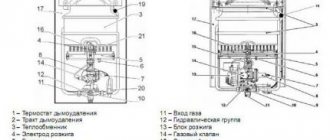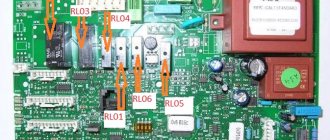Why is this happening?
This problem may have the following reasons:
- heat exchanger contamination;
- heat exchanger failure;
- corrosion inside the pipeline;
- the appearance of rust inside the risers.
The reason may also lie in the shutdown of the heat exchanger in the house. This usually occurs in cases of equipment repair or in case of an accident in external pipeline sections.
Difference in causes for open and closed water supply systems
Both of these systems are different. In open cold water, in order to heat up, it must come into contact with the coolant itself. In a closed system, water is heated by heat exchange.
The difference in the reasons why cold water flows from a faucet instead of hot water is as follows:
- high accident rate of open systems compared to closed ones due to their location (in the event of an accident on the pipeline, the water supply is completely stopped in the entire water supply system);
- low accident rate of closed systems (in the event of an accident, water continues to flow into apartments, going around the damaged section of the pipeline);
- rapid cooling of hot water in open systems due to its unstable distribution;
- stable maintenance of hot water temperature in closed systems, due to which they are less likely to fail.
Open systems often have low pressure, which means hot water does not reach consumers living on the upper floors. This requires the installation of booster pumps. In closed ones there is a large loss of water. They often need inflating pumps.
In such systems, heat exchangers often break down, due to which not hot, but cold water flows into apartment taps.
Varieties
There are three types of air vents, differing in operating principle and design:
1. Mayevsky manual tap . This is the simplest device that is controlled manually. If uneven heating of the radiator is detected, the tap can be opened with a key or any screwdriver, and then, as air leaves the radiator, turn the tap in the opposite direction.
The photo shows a Mayevsky manual type crane
2. Automatic tap . The difference between an automatic crane is the absence of manual control of its operation. Its design and operating principle are somewhat different from the functioning of a manual crane. An automatic faucet is made of brass in the form of a cylinder, but there is no needle valve in its design. Instead, a plastic float is used. How does an automatically controlled Mayevsky crane work? A plastic float, depending on the presence of air in the system, moves inside the tap and controls the opening and closing of the valve. Everything happens without human intervention.
The principle of operation of the Mayevsky automatic crane is visually demonstrated in the photo above.
All automatic taps have the ability to be manually controlled, which can be used when the passage opening becomes clogged.
3. Crane with built-in safety device . For this type of Mayevsky crane, the principle of its operation is somewhat different from the usual bleeding of air. The safety valve is able to control the coolant pressure in the system. If the coolant pressure exceeds the limit value, reaching 15 atmospheres, the valve will operate and begin to forcibly bleed the coolant from the heating system. This prevents damage to individual elements of the system in the event of sudden water hammer.
It is especially important to install air vents with safety valves in heating systems made of polypropylene and metal-plastic pipes, which may not withstand high pressure.
How to find out the reason in a particular case?

To find out the exact cause, you need to check the pipes in the basement of the house.
It is necessary to look at the condition of the pipeline section that approaches the riser. To do this, you need to invite a specialist from the management company to inspect the pipes in the basement of the house.
It is important to check the condition of the risers themselves. You should invite a specialist from the management company to check the risers for the presence of rust inside them.
In any case, you will need to check the operation of the heat exchanger in the house. It is this device that often causes interruptions in hot water supply in homes. Only a representative of the management company, who should be invited to the house upon a pre-submitted application, can check the heat exchanger for blockages and damage.
If the above options do not reveal the cause, then you should contact the water utility and generating companies servicing the house. They are responsible for the condition of the external pipeline.
After filing an application, they are required to send a representative to check the condition of external pipeline sections throughout the area of the possible accident.
Why does air accumulate in the system?
An air lock is the worst enemy of the heating system. The more air in the batteries, the worse they heat, because the air does not allow the coolant to completely fill the heating device, and it does not heat up at full power. Causes of air entry:
- Depressurization of pipes during repair work of the riser or batteries.
There are a number of other reasons for oxygen getting into pipes, but they occur very rarely.
Important! In the process of regular aeration, the metal of the heating elements undergoes corrosion, since oxygen negatively affects the structure of the material, destroying it. Such a system will last much less than heating with rare air entering the radiators.
Instructions for solving the problem
To cope with this problem, you need to follow an algorithm. It is important to know where to go and how to file and send a complaint. A separate point is the possible result of such treatment.
Where to contact?
In such situations, the first instance is the management company. She is responsible for ongoing maintenance work on the pipeline inside the house.
If the reason why cold water comes out of the tap instead of hot water in houses is due to damage to the pipeline in the area outside the houses, then you should contact the city water utility.
In case of accidents at pumping stations, it is recommended to contact the generating company that services the home to resolve the problem with hot water.
How to write an application?
The application is made in a free format. It should indicate the following points:

the name of the management company, water utility or generating company to which the complaint will be sent;- address of these organizations, their head;
- Full name of the applicant and his address;
- the very name “complaint” is in the middle of the line;
- a detailed description of the situation when it was revealed that cold water flows from the tap instead of hot;
- a specific request to the organization to resolve the situation;
- date of writing the document;
- signature of the person applying.
If necessary, you can attach documentation to the complaint that will confirm the fact of improper supply of hot water to the house.
How to file a complaint?
A claim regarding this case must be submitted only in writing. Management companies will not respond to verbal complaints from consumers. The application is sent to the management company in two copies.
A mark is placed on one of them that it has been accepted for consideration. Similarly, the complaint is forwarded to the water utility and the generating company.
Result of the request

It measures the water temperature at water intake points. Two such measurements are made.
The first is in the morning, the second is in the evening. Based on the results of the measurements taken, the management company’s employee draws up a report.
It confirms the fact that there is a disruption in the supply of hot water to the apartments. The document is made in two copies. One of them remains with the consumer.
The management company is obliged to make a recalculation based on the act of measuring the temperature at water collection points . For the next period, the consumer who submitted the application should have their DHW fees reduced.
Or he will pay for it at the same rate as for cold water, if the measurement shows the temperature of the hot water below the 40-degree mark.
If the reason lies in contamination of the heat exchanger, then the management company employee cleans it. If the problem is a device failure, the management company replaces it. It is also possible to replace only individual elements of the heat exchanger.
If the pipes become clogged, the management company worker cleans them or completely replaces a separate section of the pipeline. Also, the solution to the problem may be limited to cleaning the screens on the mixers.
History of creation
In the early 30s of the 20th century, with lower wiring, radiators were equipped with taps, through which residents of apartment buildings took large quantities of water (coolant) from the heating system for domestic use, which negatively affected the entire heating system. To combat unauthorized withdrawal of coolant, a faucet designed by Mayevsky was developed, which, due to the small diameter of the outlet, increased the time of water collection.
In 1931, 2 crane designs were created:
- Design of Mayevsky Ch.B. – the working elements of the device are made in the form of a cone.
- Design by Minsk plumber S.A. Roev. – a gasket was installed between the two parts of the tap.
Preference was given to a device with cone-shaped elements. Active use of the crane began in the heating season of 1933.
What to do if the problem is not resolved?

She acts as a supervisory authority and monitors the work of the management company.
You should also complain to the housing inspectorate about the inaction of the water utility or the failure of the organization to fulfill its duties.
It controls all organizations involved in the housing and communal services sector.
An alternative option may be to contact the local administration. A written complaint can be submitted through the reception desk. You can also send it via mail.
It is allowed to complain about management companies, water utilities and generating companies to Rospotrebnadzor and the prosecutor's office. Their function is to supervise how housing and communal services organizations carry out their work.
If these authorities do not assist in solving the problem, then you should go to court. It is necessary to file a claim. It can be sent by mail or transmitted through the court office. A number of courts allow filing claims in electronic format.
Prevention
One of the options to prevent such a situation is to regularly monitor the condition of the heat exchanger in the house. It is recommended to check the condition of the device monthly for blockages and corrosion.
For prevention, the condition of the pipeline in the basements of houses should be checked monthly. Particular attention should be paid to those areas that are connected to risers.
At the first signs of corrosion, the pipes must be cleaned immediately . The same goes for the risers themselves. Their condition must be monitored by designated employees of the management company. At the first sign of clogging, the riser needs to be thoroughly cleaned.

A way to solve the problem could be to install a separate water heater in the apartment.
This is especially true for old houses, in which the pipeline system often fails.
If there are frequent interruptions in the supply of hot water, a water heater will be able to smooth out the problem .
The resident will always have a certain supply of hot water if necessary. But this will inevitably lead to an increase in utility bills for electricity.
One option is also to install water meters with a temperature sensor in the apartment. This device will not solve the problem with the supply of hot water, but will help reduce payments for water if it is supplied to the apartment at insufficient temperature.
A water meter with a temperature sensor will help the consumer monitor the quality of hot water in his apartment.
Mayevsky crane

One of the main problems of heating systems is the inevitable release and accumulation of air in individual elements. Some parts of radiators are higher than the pipes connected to them, so they create air pockets that significantly reduce their efficiency. At the beginning of the 20th century, ordinary taps were installed to remove air from heating radiators.
In 1931 and 1933, designers Roev and Mayevsky independently invented similar devices. Some design advantages have made the Mayevsky tap more widespread, and today this device, with certain improvements, is used in almost all heating systems. By the way, in the official documentation it is called a “Needle radiator air valve,” and the name of the designer is mentioned only in the colloquial name of the faucet.
Operating principle of the Mayevsky crane
The main component of the device is a needle mechanism, which ensures high tightness and allows air to be vented if necessary. When air accumulates in a heating radiator or heated towel rail, its upper part stops heating normally, so the Mayevsky tap is always installed at the highest point. By the way, many devices already have a built-in air valve in their design from the factory.
There is both a manual and automatic version of the crane. In both cases, the main locking element is a conical rod that completely closes the bleed hole. The manual tap can be opened with a flat-head screwdriver or a special square wrench.
The automatic valve has a float that pushes the shut-off needle when the water reaches the upper level. As soon as an air pocket appears in the radiator, the float drops, the needle opens the outlet, and all excess air is released, after which the needle returns to its place.
A valve with a built-in fuse is also available, which automatically opens when the pressure in the system exceeds 15 atmospheres. This allows you to protect radiators from rupture during water hammer, but when such protection is triggered, a fairly large amount of water can enter the room (albeit much less than when a radiator ruptures).
Design Features
The device consists of a housing, a shut-off valve and a screw. For control, a tetrahedral head for a plumber's wrench or a slot for a slotted screwdriver is used. Automatic valves have a special float and spring in their design. In order for the lock to open, the water must not reach the float, and the air pressure inside the radiator must reach a certain value at which the spring will allow the mechanism to operate.
Modern models often feature a butterfly handle, which allows you to open the tap without using any tools. The presence of a handle somewhat contradicts the original idea, which was to make using the tap inconvenient (to prevent unauthorized tapping of water). But since such a problem is now irrelevant, the Mayevsky crane is no longer considered as “foolproof.”
Air valve bodies are made of brass or stainless steel. Since water in heating systems often has increased chemical activity, alloys must have high corrosion resistance. When choosing a valve, it is important to ensure that the connecting diameter matches the thread of the radiator. Devices are available for sale in all standardized sizes: 1 inch, 1/2 and 3/4 inch.
How to bleed air using a Mayevsky tap
Before this operation, it is advisable to prepare for excesses. You need to place a large bowl of water under the battery, and place a large rag next to it. Next, using a flat-head screwdriver or a square wrench, you need to turn the tap head 180 degrees counterclockwise. A characteristic hissing sound will be heard, indicating the release of air.
As soon as the water comes out, the tap must be closed in the same way. Typically, the flow section does not exceed 2 mm, due to which the air comes out quickly enough, and when the maximum level is reached, the water oozes out quite weakly, but you should not hesitate.
A strong flow of water can interfere with the release of air (even in a vertical pipe, air bubbles stop moving upward already at a water speed of 0.25 m/s). Therefore, before the procedure, it is advisable to turn off all pumps for forced circulation of the coolant to which there is access.
Valve Installation and Maintenance
In order to independently install a Mayevsky crane, no special skills or specialized equipment are required (an adjustable wrench is sufficient). Standard thread diameters are used, so the main thing is to guess the connecting size. If you need to install the faucet on a cast iron radiator, you will have to drill the hole and tap the thread yourself. There will be no other difficulties. If the radiator is connected to a centralized heating system, installation should be carried out in the summer, when there is no water in the circuit.
Due to debris in the coolant, the locking mechanism can become clogged, so it must be cleaned regularly (this can be done with a regular steel needle). Automatic valves are more vulnerable to debris, so it is better not to use them when connecting to a centralized heating system. Sometimes cleaning does not help, or the faucet starts leaking water. In such cases, it must be replaced as described above. If the thread does not give in, you can drop a little kerosene on it (applying too much force when unscrewing is unacceptable).
The article has been prepared -
https://mnogo-tepla.ru - everything for heating.
Source: https://zen.yandex.ru/media/stroika/kran-maevskogo-5a7d950048267713d9cffa86











